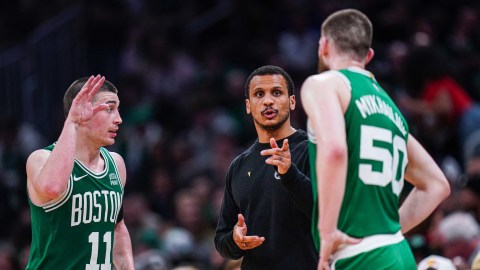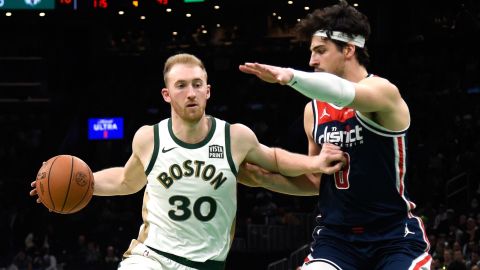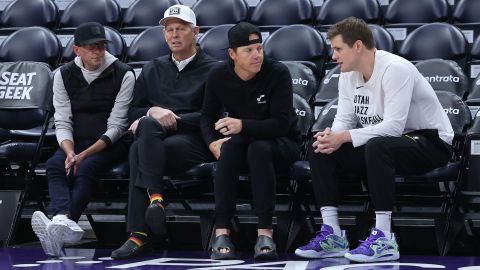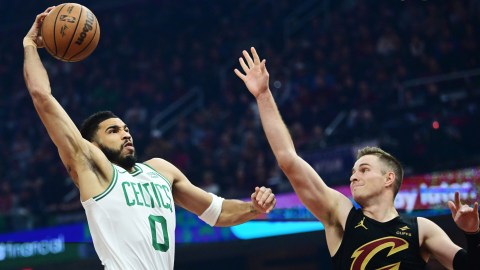 WALTHAM, Mass. — The long-sleeve T-shirt, three-quarter-length pants and running shoes that have become Rajon Rondo‘s staple practice attire were conspicuously missing when the Celtics took the court on Tuesday. Two days later, the reality of the situation has had plenty of time to sink in.
WALTHAM, Mass. — The long-sleeve T-shirt, three-quarter-length pants and running shoes that have become Rajon Rondo‘s staple practice attire were conspicuously missing when the Celtics took the court on Tuesday. Two days later, the reality of the situation has had plenty of time to sink in.
Rondo’s season-ending injury was not just some bad dream, and the Celtics really must be ready to move on without their All-Star point guard.
“If we’re not, we’re going to have to be,” Leandro Barbosa said. “It’s time for us to realize we’re not going to have him for the whole season. It’s pretty sad, but it is what it is. We’re going to have to stick together and move forward.”
Despite the trade speculation prompted by the torn anterior cruciate ligament in Rondo’s right knee, the most realistic way for the Celtics to progress might be to simply see how their existing roster of healthy players fares. Celtics president of basketball operations Danny Ainge faces considerable obstacles to “blowing up” the team, and some of the more attractive assets — such as Paul Pierce, whose contract is only partially guaranteed beyond this season — might not be amenable to a move.
While the Celtics will find it difficult to be better without Rondo, they should be extremely intriguing to watch, particularly if they do not make a major move. Aside from watching a truly elite team operate at peak efficiency, few things in basketball are as interesting as watching a team try to “figure it out” under adversity.
One of the most fascinating things about the Miami Heat over the last two seasons, for instance, was how they gradually learned to play together. It took more than two full seasons and two rounds of the playoffs before coach Erik Spoelstra finally found a successful way to implement LeBron James, Dwyane Wade and Chris Bosh all together, and Celtics coach Doc Rivers, naturally, hopes it does not take him that long to figure out how to succeed without Rondo.
In the aftermath of the Celtics’ victory over Miami, coupled with the news of Rondo’s injury, there were bold declarations that the Celtics would flourish without Rondo and equally definitive claims that they were finished. Evidence could be found for both arguments. Pierce was forced to take difficult shots against an attacking Heat defense. Jason Terry played one of his best offensive games Sunday in Rondo’s absence. Barbosa and Courtney Lee sounded excited on Tuesday about the impending bump in their playing time. The fact is, nobody knows how the Celtics will respond, and that uncertainty makes them a must-watch team over the next three weeks before the Feb. 21 trade deadline.
“It may help Jet, just because he’ll have the ball in his hands more,” Rivers said. “And it could hurt some guys. That’s the unanswered question. I’m hoping it helps some guys, but you never know.”
There is no question the Celtics must make adjustments, but Rivers insisted that individual players’ roles will not change. None of the Celtics’ remaining guards is a true point guard — not even Avery Bradley, who inherits the nominal “starting point guard” designation — so every player will share responsibilities in bringing the ball up the court and initiating the offense. That includes frontcourt players like Kevin Garnett, Jeff Green and Pierce as well as the guards.
In the past, teams have responded to a lack of a true point guard in various ways. One of the more drastic approaches, as Garnett recalled last season, was when Timberwolves coach Flip Saunders made him a 6-foot-11 point guard after Sam Cassell injured his back prior to the 2004 Western Conference Finals. (Do not expect Rivers to copy that strategy. Not only is Garnett nine years older, but he has also called those six games “the worst experience of my life.”) Lately, Rivers has favored a healthy dose of dribble-handoffs or sending a big man back to set a screen in the backcourt or near midcourt to help relieve the ball pressure on his guards.
That is a taxing approach for everyone, in particular Garnett and Pierce, who cannot simply jog to their spots on the court as they would when Rondo was healthy. They will have to join the rest of their teammates in working harder to put the ball in play, and the offense will need to feature more passing and less dribbling by necessity.
“When [Rondo is] dribbling the ball, things happen easier,” Barbosa said. “He’s a guy that can get 10, 11 assists a game, so things happen easy. Without him we’re going to have to move the ball and make sure we work together to get open shots and to get things going.”
For the final 38 games of this season, plus however many are in store for the Celtics in the playoffs, Rondo will not be around to dominate the ball. Depending on one’s perspective, that is either good or bad. The Celtics look at it as neither — just different. With Rondo, Rivers was struggling to find the right buttons to push with an underachieving group. Without Rondo, he still is.
“It’s a tough situation,” Pierce said. “You feel bad for your teammate going down like that for the season with an injury. You don’t wish that upon any NBA player, let alone somebody that you play with. But we have to move forward.”
However the Celtics proceed, the rest of the league will not want to miss it.
Have a question for Ben Watanabe? Send it to him via Twitter at @BenjeeBallgame or send it here.



